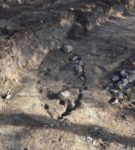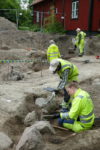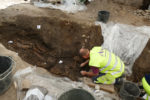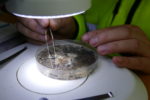 Two extremely rare boat graves have been discovered in an excavation of a vicagare in the village of Gamla Uppsala outside of Uppsala, southeastern Sweden. The location of yearly Things, religious celebrations, royal residences and burial mounds from prehistory through the Middle Ages, Gamla Uppsala is one of the most important archaeological sites in Sweden, so when the Swedish Church planned to build an addition to the vicarage, archaeologists from the National Historical Museums surveyed the construction site.
Two extremely rare boat graves have been discovered in an excavation of a vicagare in the village of Gamla Uppsala outside of Uppsala, southeastern Sweden. The location of yearly Things, religious celebrations, royal residences and burial mounds from prehistory through the Middle Ages, Gamla Uppsala is one of the most important archaeological sites in Sweden, so when the Swedish Church planned to build an addition to the vicarage, archaeologists from the National Historical Museums surveyed the construction site.
 First the team unearthed a well and basement from a late medieval building. Underneath those remains, they found the two boat graves, burials in which deceased were inhumed in a boat dug into the ground and covered with soil. They date to the Viking era (800-1050 A.D.) or the Vendel Period (550-790 A.D.), the centuries bridging the Migration Period and the Viking Period. This is a sensational find, as only 10 known boat graves have been discovered in all of Sweden, and it’s been 50 years since the last boat grave was found.
First the team unearthed a well and basement from a late medieval building. Underneath those remains, they found the two boat graves, burials in which deceased were inhumed in a boat dug into the ground and covered with soil. They date to the Viking era (800-1050 A.D.) or the Vendel Period (550-790 A.D.), the centuries bridging the Migration Period and the Viking Period. This is a sensational find, as only 10 known boat graves have been discovered in all of Sweden, and it’s been 50 years since the last boat grave was found.
 One of the two was damaged, likely when the late medieval basement was built, but the other is intact. It contained the skeletal remains of an adult male buried in the stern of the boat. He was interred with valuable personal belongings including a sword, spear, shield and an ornate comb.
One of the two was damaged, likely when the late medieval basement was built, but the other is intact. It contained the skeletal remains of an adult male buried in the stern of the boat. He was interred with valuable personal belongings including a sword, spear, shield and an ornate comb.
 The bow of the boat held the remains of a dog and a horse. Iron fittings from the horse’s gear were still in place. The horse and dog probably belonged to the man and were slain and buried with him to accompany their master into death.
The bow of the boat held the remains of a dog and a horse. Iron fittings from the horse’s gear were still in place. The horse and dog probably belonged to the man and were slain and buried with him to accompany their master into death.
 Remains of the boats were also discovered. Iron rivets have survived, and even more rarely, so has some of the wooden planking. The damaged boat burial appears to have been the largest, with an estimated length of at least 23 feet. The elements from the boats are of particular archaeological importance because they may reveal whether the vessels were old or specifically manufactured for funerary purposes.
Remains of the boats were also discovered. Iron rivets have survived, and even more rarely, so has some of the wooden planking. The damaged boat burial appears to have been the largest, with an estimated length of at least 23 feet. The elements from the boats are of particular archaeological importance because they may reveal whether the vessels were old or specifically manufactured for funerary purposes.
 The untouched grave is a boon for archaeologists because this will be the first time they have an opportunity to use the latest and greatest technologies and scientific analyses on a boat grave. There is so much we can learn from the smallest samples of soil, organic material, bone and metal that wasn’t even a remote possibility 50 years ago.
The untouched grave is a boon for archaeologists because this will be the first time they have an opportunity to use the latest and greatest technologies and scientific analyses on a boat grave. There is so much we can learn from the smallest samples of soil, organic material, bone and metal that wasn’t even a remote possibility 50 years ago.
 While the studies are ongoing, a selection of the finds will be on display this summer at Gamla Uppsala Museum and this fall at the Historical Museum in Stockholm.
While the studies are ongoing, a selection of the finds will be on display this summer at Gamla Uppsala Museum and this fall at the Historical Museum in Stockholm.